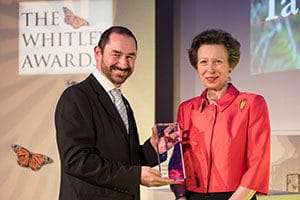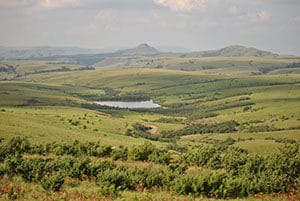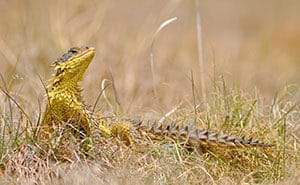Conservation Award for Africa
[caption id="attachment_2558" align="alignright" width="300"] Ian Little, receiving the award from HRM Princess Ann
Ian Little, receiving the award from HRM Princess Ann
Dr Ian Little from the South African Endangered Wildlife Trust receives 2017 Whitley Award
Dr Ian Little from the South African Endangered Wildlife Trust (EWT), seen here receiving his Whitley award from HRM Princess Ann, was one of the prestigious winners this year for his determined efforts to protect grasslands in South Africa. Ian is one of six individuals to have been awarded a share of the prize money worth £210,000, winning the Whitley Award donated by the Garfield Weston Foundation.
Grasslands are the most endangered vegetation type in South Africa because this is where most of the agriculture, mining and urban development has taken place. The work of Dr Little focuses on several threatened species and their habitats which include the Wattled Crane, the Yellow-breasted Pipit, Rudd’s Lark, the White–bellied Korhaan and others. Over the next five years, Dr Little wants to establish a large grassland and forest escarpment protected area to help protect what remaining wild areas we have.
[caption id="attachment_2560" align="alignleft" width="300"] Vital grasslands in the Eastern Great Escarpment of South Africa
Vital grasslands in the Eastern Great Escarpment of South Africa
Demand for fresh water is expected to outstrip supply in South Africa by 2025. The Eastern Great Escarpment of South Africa provides catchment services for three of the country’s largest rivers, making it a vital source of water for cities such as Durban and Johannesburg in one of the world’s most arid nations. As the world’s third most biodiverse country, these grasslands support a plethora of plants and animals found nowhere else, including golden moles and the sungazer lizard. Despite their importance, less than 3% of grasslands in South Africa are protected. Intensive livestock farming, coal mining and gas exploration are inflicting untold damage – with fracking now an imminent threat. Ian Little of the Endangered Wildlife Trust works with farmers to champion conservation of grassland habitat. Working with farmers and tribal leaders, Ian is building capacity for sustainable farming and introducing improved management practices, such as less intensive grazing and burning regimes to decrease pressure on grasslands and boost productivity. He has already secured 60,000 hectares of grassland for conservation purposes; a figure Ian plans to increase with his Whitley Award by creating a corridor of legally protected areas linking with others along the escarpment. In doing so he will safeguard these grasslands and the important source of freshwater they provide.
Biodiversity conservation required strong commitment
[caption id="attachment_2561" align="alignright" width="300"] The endemic sungazer lizard
The endemic sungazer lizard
Biodiversity conservation is not for the faint hearted, as the 2017 set of six Whitley Fund for Nature (WFN) conservation award winners attests. These heroic winners are successfully fighting against the massive destruction of pristine forested landscapes in developing countries, facing down large corporations and their own governments, mobilizing local communities whose livelihoods depend on the resources provided by the forests, and taking huge efforts to save endangered species. Many are young people, with a number of young women, and all have incredible energy and courage to face up to the completely immoral destruction of natural landscapes, watersheds, ancient forests and rare species. In fact, WNF winners are the ‘action heroes’ of the conservation world. They identify and address threats to wildlife by working with local communities to find mutually beneficial solutions to problems including the loss of natural habitat, overexploitation of wild resources, and human-wildlife conflict. Importantly, the WFN winners are usually nationals of the countries where they work, and by training local people, are creating the next generation of conservation leaders.
Many of the WFN winners go on to creating important conservation organisations and changing wildlife policy in their countries or around the world. For example, in 1994, WFN supported the first person to research seahorses in the wild, Amanda Vincent. Her NGO, Project Seahorse, has since developed into an international organisation working at all levels, from establishing over 30 community-managed marine reserves in the Philippines, to changing seahorse trade policy in 175 countries.
The Whitley Fund for Nature (WFN)
[caption id="attachment_2559" align="alignright" width="200"] Ian Little working in the field
Ian Little working in the field
The Whitley Fund for Nature (WFN) is a UK registered fundraising and grant-giving nature conservation charity offering recognition, training and grants to support the work of proven grassroots conservation leaders in developing countries. They aim to find and fund the most effective grassroots conservation leaders in developing countries. WFN gives funding, training and recognition to local conservation leaders working in resource-poor, biodiversity-rich countries. Also, WFN support the scale-up of projects with a track record of success, founded on scientific evidence and community involvement and fund practical work that will have a long-lasting impact on the ground. The Whitley Fund will provide a platform for winners to boost their national and international profile and work with winners to improve awareness of the serious problems facing biodiversity worldwide and address them through effective and inspiring solutions.
WFN prides itself in attracting applications from leaders in locations where funds are hardest to raise, most needed, and have the largest conservation impact. WNF also supports nature conservationists who are usually nationals of the countries where they work, who are often best placed to bring about change, build capacity, and enable projects to become self-supporting. What is interesting is the way they give their winners PR support and professional media and speech training to help raise their national and international profile and grow their impact – hence the inspiring YouTube videos narrated by Sir David Attenborough who is one of the trustees.
There have been at least 40 WMF awards in Africa.
The 2016-2017 Whitley awards for conservation
For the 2016-2017 award, six winners were selected from a field of 166 applicants from 66 countries, and are:
Ximena Velez-Liendo https://www.youtube.com/watch?v=Mf3ZzujG2ns
Alexander Blanco https://www.youtube.com/watch?v=qC7fniMgEds
Ian Little https://www.youtube.com/watch?v=0EpUOeGc994
Purnina Barman https://www.youtube.com/watch?v=-eWLp_eCWBE
Sanjay Gubbi https://www.youtube.com/watch?v=MFzgzlqJH18
Indira Lacerna-Widmann https://www.youtube.com/watch?v=mqQW-tnWWBU
Material sourced from : https://whitleyaward.org/2017/05/whitley-awards-2017-finalists/
 Ian Little, receiving the award from HRM Princess Ann
Ian Little, receiving the award from HRM Princess AnnDr Ian Little from the South African Endangered Wildlife Trust receives 2017 Whitley Award
Dr Ian Little from the South African Endangered Wildlife Trust (EWT), seen here receiving his Whitley award from HRM Princess Ann, was one of the prestigious winners this year for his determined efforts to protect grasslands in South Africa. Ian is one of six individuals to have been awarded a share of the prize money worth £210,000, winning the Whitley Award donated by the Garfield Weston Foundation.
Grasslands are the most endangered vegetation type in South Africa because this is where most of the agriculture, mining and urban development has taken place. The work of Dr Little focuses on several threatened species and their habitats which include the Wattled Crane, the Yellow-breasted Pipit, Rudd’s Lark, the White–bellied Korhaan and others. Over the next five years, Dr Little wants to establish a large grassland and forest escarpment protected area to help protect what remaining wild areas we have.
[caption id="attachment_2560" align="alignleft" width="300"]
 Vital grasslands in the Eastern Great Escarpment of South Africa
Vital grasslands in the Eastern Great Escarpment of South AfricaDemand for fresh water is expected to outstrip supply in South Africa by 2025. The Eastern Great Escarpment of South Africa provides catchment services for three of the country’s largest rivers, making it a vital source of water for cities such as Durban and Johannesburg in one of the world’s most arid nations. As the world’s third most biodiverse country, these grasslands support a plethora of plants and animals found nowhere else, including golden moles and the sungazer lizard. Despite their importance, less than 3% of grasslands in South Africa are protected. Intensive livestock farming, coal mining and gas exploration are inflicting untold damage – with fracking now an imminent threat. Ian Little of the Endangered Wildlife Trust works with farmers to champion conservation of grassland habitat. Working with farmers and tribal leaders, Ian is building capacity for sustainable farming and introducing improved management practices, such as less intensive grazing and burning regimes to decrease pressure on grasslands and boost productivity. He has already secured 60,000 hectares of grassland for conservation purposes; a figure Ian plans to increase with his Whitley Award by creating a corridor of legally protected areas linking with others along the escarpment. In doing so he will safeguard these grasslands and the important source of freshwater they provide.
Biodiversity conservation required strong commitment
[caption id="attachment_2561" align="alignright" width="300"]
 The endemic sungazer lizard
The endemic sungazer lizardBiodiversity conservation is not for the faint hearted, as the 2017 set of six Whitley Fund for Nature (WFN) conservation award winners attests. These heroic winners are successfully fighting against the massive destruction of pristine forested landscapes in developing countries, facing down large corporations and their own governments, mobilizing local communities whose livelihoods depend on the resources provided by the forests, and taking huge efforts to save endangered species. Many are young people, with a number of young women, and all have incredible energy and courage to face up to the completely immoral destruction of natural landscapes, watersheds, ancient forests and rare species. In fact, WNF winners are the ‘action heroes’ of the conservation world. They identify and address threats to wildlife by working with local communities to find mutually beneficial solutions to problems including the loss of natural habitat, overexploitation of wild resources, and human-wildlife conflict. Importantly, the WFN winners are usually nationals of the countries where they work, and by training local people, are creating the next generation of conservation leaders.
Many of the WFN winners go on to creating important conservation organisations and changing wildlife policy in their countries or around the world. For example, in 1994, WFN supported the first person to research seahorses in the wild, Amanda Vincent. Her NGO, Project Seahorse, has since developed into an international organisation working at all levels, from establishing over 30 community-managed marine reserves in the Philippines, to changing seahorse trade policy in 175 countries.
The Whitley Fund for Nature (WFN)
[caption id="attachment_2559" align="alignright" width="200"]
 Ian Little working in the field
Ian Little working in the fieldThe Whitley Fund for Nature (WFN) is a UK registered fundraising and grant-giving nature conservation charity offering recognition, training and grants to support the work of proven grassroots conservation leaders in developing countries. They aim to find and fund the most effective grassroots conservation leaders in developing countries. WFN gives funding, training and recognition to local conservation leaders working in resource-poor, biodiversity-rich countries. Also, WFN support the scale-up of projects with a track record of success, founded on scientific evidence and community involvement and fund practical work that will have a long-lasting impact on the ground. The Whitley Fund will provide a platform for winners to boost their national and international profile and work with winners to improve awareness of the serious problems facing biodiversity worldwide and address them through effective and inspiring solutions.
WFN prides itself in attracting applications from leaders in locations where funds are hardest to raise, most needed, and have the largest conservation impact. WNF also supports nature conservationists who are usually nationals of the countries where they work, who are often best placed to bring about change, build capacity, and enable projects to become self-supporting. What is interesting is the way they give their winners PR support and professional media and speech training to help raise their national and international profile and grow their impact – hence the inspiring YouTube videos narrated by Sir David Attenborough who is one of the trustees.
There have been at least 40 WMF awards in Africa.
The 2016-2017 Whitley awards for conservation
For the 2016-2017 award, six winners were selected from a field of 166 applicants from 66 countries, and are:
- Ximena Velez-Liendo: An uphill climb: enabling coexistence of Andean bears and farmers in the Bolivian mountains
- Alexander Blanco: Nest protectors: conserving Venezuela’s magnificent harpy eagles as a rainforest flagship
- Ian Little: Custodians of South Africa’s threatened grassland biodiversity
- Purnima Barman: Inspiring women to protect Assam’s greater adjutant and its habitat, India
- Sanjay Gubbi: Reducing deforestation in Karnataka’s tiger corridors, India
- India Lacerna-Widmann: Partnering with prisoners to safeguard the Critically Endangered Philippine cockatoo
Ximena Velez-Liendo https://www.youtube.com/watch?v=Mf3ZzujG2ns
Alexander Blanco https://www.youtube.com/watch?v=qC7fniMgEds
Ian Little https://www.youtube.com/watch?v=0EpUOeGc994
Purnina Barman https://www.youtube.com/watch?v=-eWLp_eCWBE
Sanjay Gubbi https://www.youtube.com/watch?v=MFzgzlqJH18
Indira Lacerna-Widmann https://www.youtube.com/watch?v=mqQW-tnWWBU
Material sourced from : https://whitleyaward.org/2017/05/whitley-awards-2017-finalists/
Related Posts
By accepting you will be accessing a service provided by a third-party external to https://mountainresearchinitiative.org/







